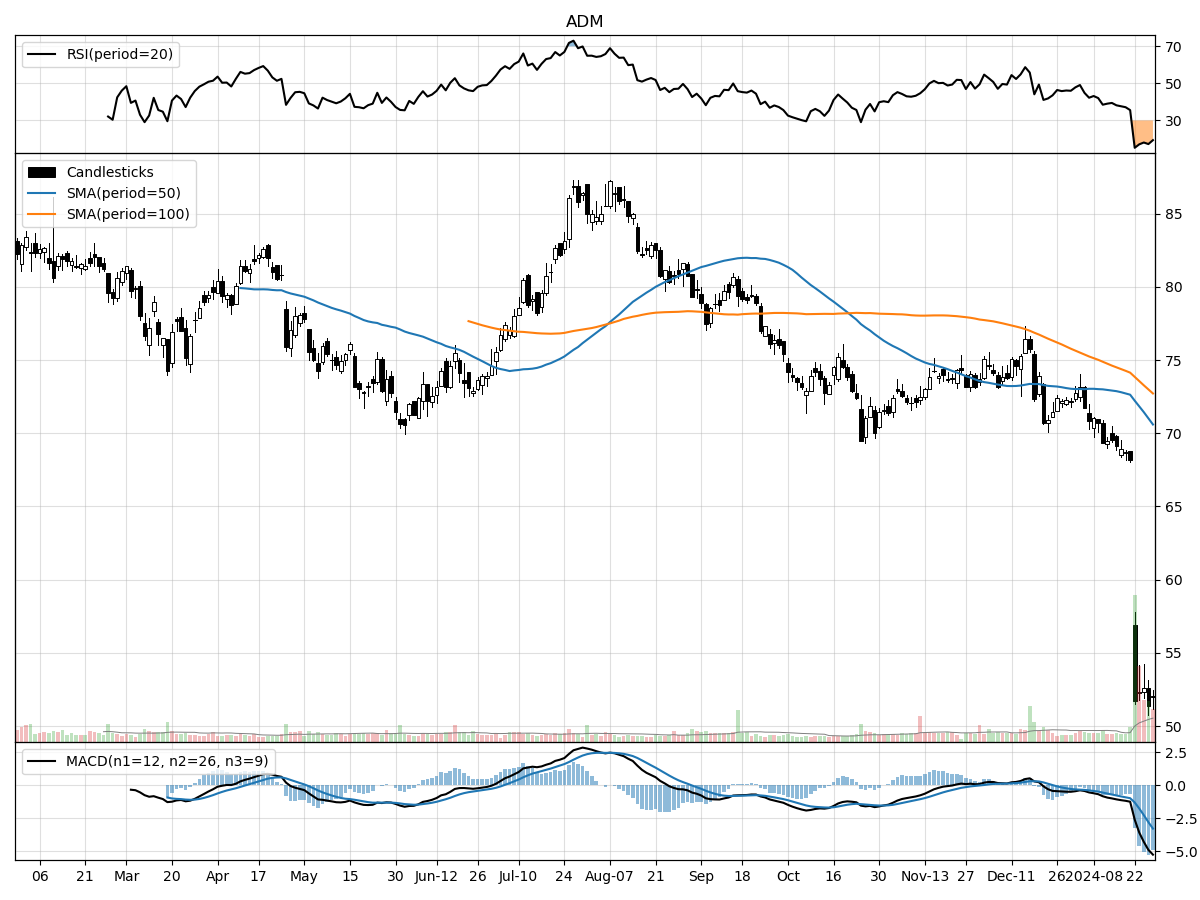Archer-Daniels-Midland Company (ADM), Large Cap AI Study of the Week
January 30, 2024
Weekly AI Pick from the S&P 500
Company Overview
Archer-Daniels-Midland Company (ADM) is a leading global agricultural processor and food ingredient provider, with a focus on sustainability and innovation. The company operates through several segments including Ag Services and Oilseeds, Carbohydrate Solutions, and Nutrition, offering a diverse range of products such as plant-based meats, flours, oils, sweeteners, animal feeds, and industrially-derived products like ethyl alcohol for sanitizers and ethanol for fuel. ADM is committed to reducing its environmental footprint through its "Strive 35" plan and invests in research and development to enhance its product offerings and customer interactions.
ADM's business strategy emphasizes sustainable practices, aiming to align with the United Nations Sustainable Development Goals, particularly in areas like Zero Hunger and Climate Action. The company has made significant progress in reducing greenhouse gas emissions and waste, and is actively working on developing low carbon, bio-based products, including sustainable aviation fuel and bioplastics in partnership with LG Chem. ADM also focuses on expanding its global presence through strategic acquisitions, joint ventures, and partnerships, and invests in ventures that contribute to geographic and product line expansion.
The company has a strong governance structure with a dedicated Sustainability Committee and Chief Sustainability Officer to integrate sustainability into its business operations. ADM's strategic growth leverages sustainability trends to differentiate its products and services, and it conducts scenario analyses to mitigate risks associated with climate change. With a workforce of approximately 42,000 employees globally, ADM values human capital and diversity, ensuring competitive compensation and benefits, and prioritizing integrity, performance, innovation, and inclusion. The company's board reflects this commitment with 58% diversity. Overall, ADM is positioned for revenue growth through the development of environmentally friendly products and its commitment to sustainable agriculture practices.
By the Numbers
Annual 10-K Report Summary for Fiscal Year Ending December 31, 2022:
- Net earnings: Increased by 60% to $4.3 billion
- Segment operating profit: Climbed by 41% to $6.5 billion
- Revenues: Jumped to $101.556 billion, up from $85.249 billion in 2021
- Cost of products sold: Rose to $94 billion
- Gross profit: Increased by 26% to $7.6 billion
- Selling, general, and administrative expenses: Increased by 12% to $3.4 billion
- Adjusted EBITDA: Rose by $1.923 billion to $6.830 billion
- Adjusted EPS: Increased to $7.85 from $5.19
- Cash from operating activities: Decreased to $3.5 billion
- Cash used in investing activities: Lower at $1.4 billion
- Cash used in financing activities: Rose to $2.5 billion
- Dividends: Increased to $0.9 billion
- Cash and equivalents: $1.0 billion
- Current ratio: 1.5 to 1
- Shareholders' equity: $24.3 billion
- Planned capital expenditures for the following year: $1.3 billion
- Decrease in purchase obligations: From $18.6 billion to $15.8 billion
Quarterly 10-Q Report Summary for Q3 2023:
- Net earnings: Decreased by $0.2 billion year over year to $0.8 billion
- Segment operating profit: Declined from $1.6 billion to $1.4 billion
- Adjusted segment operating profit: Decreased by $0.1 billion to $1.5 billion
- Revenues: Fell by $3.0 billion to $21.7 billion
- Gross profit: Remained at $1.8 billion
- Total segment operating profit: Decreased by $138 million to $1,421 million
- Adjusted segment operating profit: Dropped by $87 million to $1,492 million
- Ag Services and Oilseeds segment: 21% decline in operating profit
- Carbohydrate Solutions operating profit: Increased by 49%
- Nutrition operating profit: Fell by 22%
- Other Business operating profit: Improved by $28 million
- Corporate net charge: Increased to $390 million
Nine Months Ending September 30, 2023:
- Earnings before income taxes: Decreased by $199 million to $1.031 billion
- Adjusted EBITDA: Declined by $148 million to $1.491 billion
- Net earnings attributable to controlling interests: Fell by $0.4 billion to $2.9 billion
- Revenues: Decreased by $4.7 billion to $70.957 billion
- Costs of products sold: Decreased by $4.6 billion
- Total segment operating profit: Decreased by $273 million to $4,665 million
- Net interest expense: Rose by $87 million
- Unallocated corporate costs: Increased by $81 million
- Adjusted segment operating profit: Dropped by $139 million to $4,845 million
These figures provide a snapshot of ADM's financial health and performance over the specified periods, indicating areas of growth and decline.
Stock Performance and Technical Analysis

The technical analysis of the stock suggests that it is currently experiencing a significant downtrend. The stock price is only 1 percent above its 52-week low and is trading 40 percent below its 52-week high, indicating that the stock has faced substantial selling pressure over the past year and may not have found its bottom yet. The recent price action, with a substantial drop of nearly 28% in the last month and a similar decline over the last three months, reinforces the bearish sentiment surrounding the stock.
Volume is an essential indicator in technical analysis, as it provides insight into the momentum behind price movements. The recent daily volume of 7,757,310 shares is considerably higher than the longer-term average of 3,336,158.4 shares, suggesting that the downward price movement is accompanied by strong selling activity, which could be interpreted as a lack of confidence among investors. High volume coupled with a declining price typically signifies that the downward trend is strong and may persist.
Additional technical indicators such as the Money Flow Index (MFI) and the Moving Average Convergence Divergence (MACD) provide further insight. The MFI being indicative of heavy selling pressure and the stock being under distribution implies that more investors are selling the stock than buying it, leading to a continuous outflow of money from the stock. A bearish MACD value of -3.27 signals negative momentum and could be interpreted as a sell signal by technical analysts. The MACD is a trend-following momentum indicator that shows the relationship between two moving averages of a stock's price, and a negative value indicates that the short-term average is below the long-term average, suggesting downward momentum.
In summary, the technical indicators present a bearish outlook for the stock. Investors considering this stock should be cautious and may want to look for signs of a reversal or stabilization in the stock price and an improvement in the technical indicators before considering an investment. It's also critical to complement this technical analysis with fundamental analysis and consider any recent news or events that might affect the company's stock price.

The ‘Bull’ Perspective
Archer-Daniels-Midland Co (ADM): A Resilient Investment Amidst Global Uncertainty
Summary:
- Robust Financial Performance: ADM's financial resilience is evident in its ability to maintain a gross profit of $1.8 billion despite a challenging quarter.
- Strategic Investments in Innovation and Sustainability: ADM is proactively investing in digital advancements and sustainability, with goals like 'Strive 35' set for 2035.
- Diversified Global Operations: Operating in over 70 countries, ADM's diversified portfolio mitigates risks associated with geopolitical tensions and market volatility.
- Commodity Market Expertise: ADM's expertise in navigating the commodity market is demonstrated by its strategic use of derivative contracts and risk management strategies.
- Positive Economic Indicators: The recent strong economic data in the U.S. and the potential for Fed rate cuts suggest a favorable environment for ADM's continued growth.
Elaboration:
- Robust Financial Performance
Despite a decrease in net earnings to $0.8 billion in the latest quarter, ADM showcased its financial robustness with a maintained gross profit of $1.8 billion. While revenues fell by $3.0 billion to $21.7 billion, this was primarily due to lower sales prices, which were partially offset by increased sales volumes. The company's ability to manage a decrease in the cost of products sold, reflecting lower average commodity costs, while keeping gross profits stable, is a testament to its effective cost management and operational efficiency. Furthermore, ADM's total segment operating profit, although decreased, still amounted to a substantial $1,421 million, underscoring the company's solid financial footing. - Strategic Investments in Innovation and Sustainability
ADM is not just resting on its laurels; it is actively investing in its future. The company's dedication to innovation, particularly in digital advancements, positions it to enhance customer experiences and streamline operations. On the sustainability front, ADM has set ambitious goals like 'Strive 35' for 2035 to reduce greenhouse gas emissions, energy, and water intensity, demonstrating its commitment to environmental responsibility. These initiatives not only improve ADM's operational efficiency but also increase its appeal to environmentally conscious investors and customers, which is increasingly important in today's market. - Diversified Global Operations
With a presence in over 70 countries, ADM's global diversification is a critical risk mitigation factor. This international footprint helps the company spread its exposure across multiple markets, reducing the impact of any single geopolitical event or regional economic downturn. Despite the conflict in Ukraine, ADM's assets in the region represent less than 1% of total current assets, indicating a well-managed exposure to geopolitical risks. Moreover, the company's strategies to manage currency risks further enhance its resilience against global economic fluctuations. - Commodity Market Expertise
ADM's adept handling of the commodity market is central to its success. The company's strategic use of derivative contracts to hedge against price volatility in energy-related products like ethanol and biodiesel showcases its market expertise. With the agricultural and non-agricultural commodity prices directly affecting profitability, ADM's ability to efficiently manage procurement and merchandising activities is a significant competitive advantage. This expertise is particularly valuable in an environment where commodity prices are influenced by multiple factors, including geopolitical tensions and global trade policies. - Positive Economic Indicators
The broader economic context provides a tailwind for ADM's future growth. Recent data points to a robust U.S. economy, with manufacturing PMI reaching its highest level since October 2022. Additionally, the moderation in inflation and the Federal Reserve's potential rate cuts create an optimistic outlook for businesses like ADM. Historically, market performance has been favorable when the Fed begins a rate-cutting cycle without a recession, with the average 12-month return after the first Fed rate cut being around 7.6% in such periods. As the economy heads towards a 'soft landing' in 2024, ADM is well-positioned to benefit from these market dynamics.
In conclusion, Archer-Daniels-Midland Co's robust financial performance, strategic investments in innovation and sustainability, diversified global operations, commodity market expertise, and the positive economic backdrop make it a compelling investment opportunity. While there are risks inherent in any business, ADM's proactive management and strategic positioning bode well for its future success. Investors looking for a resilient company with a strong track record and forward-looking vision would do well to consider ADM as a key addition to their investment portfolios.

The ‘Bear’ Perspective
Why Investors Should Be Cautious About Archer-Daniels-Midland Co (ADM)
- Commodity Market Volatility: ADM's profitability is highly sensitive to commodity price fluctuations, which can lead to unpredictable financial results.
- Geopolitical Risks: Operations in unstable regions, such as Ukraine, introduce significant risks of supply chain disruptions and asset impairments.
- Regulatory and Environmental Pressures: Stringent regulations and sustainability goals could increase operating costs and capex requirements.
- Cybersecurity and Operational Risks: Dependency on IT systems and potential cyber threats pose significant risks to business continuity.
- Competitive Industry Dynamics: Intense competition and the need for constant innovation can strain ADM's resources and potentially erode market share.
Detailed Analysis:
- Commodity Market Volatility:
ADM operates in a sector that is inherently exposed to the volatility of commodity markets. Prices of agricultural commodities can swing widely due to factors such as weather events, crop diseases, and changes in global demand. In Q3 2023, ADM's revenues fell by $3.0 billion to $21.7 billion, largely due to lower sales prices, which were partly offset by increased sales volumes. The company's net earnings also decreased significantly year over year, illustrating how sensitive the bottom line is to market conditions. With processed volumes in oilseeds and corn increasing, the company faces a continuous risk that any adverse movement in commodity prices could lead to a further squeeze on margins and profitability. - Geopolitical Risks:
The ongoing conflict in Ukraine poses direct risks to ADM's operations and indirectly affects global commodity markets. With assets in Ukraine representing less than 1% of total current assets as of September 30, 2023, there is a tangible risk of asset impairment. Moreover, the conflict can lead to broader disruptions in trade flows and supply chains, which could hamper ADM's ability to source raw materials and sell products, potentially leading to further revenue declines and increased costs. - Regulatory and Environmental Pressures:
ADM's commitment to environmental responsibility and full traceability in its soy supply chains by 2022, along with its 'Strive 35' goals for 2035, underscore the company's focus on sustainability. However, these initiatives come with significant cost implications. The pursuit of reduced greenhouse gas emissions, energy, and water intensity may require substantial capital expenditures and operational changes that could impact short-term profitability. Moreover, non-compliance with ever-evolving environmental regulations could result in hefty fines and reputational damage. - Cybersecurity and Operational Risks:
ADM's reliance on digital systems to enhance customer experience and operational efficiency makes it vulnerable to cybersecurity threats. Any significant IT system disruption or data breach could lead to operational downtime, loss of proprietary information, and damage to the company's reputation. In an era where cyber threats are becoming increasingly sophisticated, ADM must invest heavily in cybersecurity measures to safeguard its operations, which adds to the company's ongoing expenses. - Competitive Industry Dynamics:
The agribusiness sector is highly competitive, and ADM must continually innovate to maintain its market position. This requires significant investment in research and development, as well as in acquiring and integrating new businesses. The company's Nutrition segment, for instance, saw a decrease in operating profit by 22% in Q3 2023, reflecting the challenges of maintaining growth in competitive markets. There is a persistent risk that without sustained and successful innovation, ADM could lose market share to competitors, which could lead to further pressure on revenues and margins.
In conclusion, while Archer-Daniels-Midland Co (ADM) has a diversified portfolio and a global presence, the risks associated with commodity market volatility, geopolitical instability, regulatory and environmental pressures, cybersecurity threats, and competitive industry dynamics should give investors pause. These factors can significantly impact ADM's financial performance and, as such, warrant a cautious approach to investing in the company's stock.




Comments ()